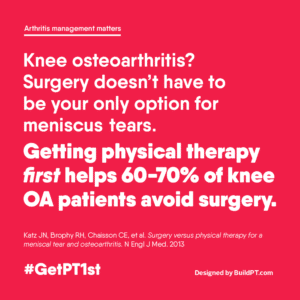Meniscus Injuries
Cartilage Tears
Your Meniscus is a crescent-shaped cartilage in the knee joint. It’s one of the more commonly injured, and most misunderstood, parts of the knee. Due to the low levels of irritation associated with Meniscus Cartilage Tears, many people ignore the discomfort, believing a wait-and-see approach is best. While that’s fine if you want to wait and see when your surgery will be, our advice would be to concentrate on healing your injury to prevent future complications that could impact your mobility. This won’t go away on its own.
Treatment for Meniscus Injuries at Focus Physiotherapy starts with an assessment of the injured knee, and a discovery session to understand the damage. We also look at lifestyle factors to find out what daily movements could aggravate your knee injury. Because your meniscus acts as a shock absorber within the knee capsule, certain prolonged activities may make your injury worse. By understanding the cause and effect of your discomfort, you will be participating in your healing—even when you’re away from our clinic.
Meniscus Injuries recover slowly due to their poor blood supply, so you’ll need to allow time for proper healing. Using manual intervention, as well as our extensive range of equipment, Focus Physiotherapy healthcare professionals will be able to increase circulation to the affected area, and teach you techniques to decrease the stress on your joints during recovery.
Surgery doesn’t have to be your only option for meniscus tears, getting physiotherapy first helps 60 to 70% of knee OA patients avoid surgery!
Knee Ligament Injuries
Connective Tissue Injuries
Ligaments are bands of connective tissue that attach your bones to each other. There are four main Knee Ligaments:
- Anterior Cruciate Ligament – ACL
- Posterior Cruciate Ligament – PCL
- Medial Collateral Ligament – MCL
- Lateral Collateral Ligament – LCL
Each ligament serves a specific purpose, and performs an important role in your daily activities. Damage to knee ligaments typically involves surrounding soft tissue tears that, if not properly assessed, can be missed, resulting in improper treatment and poor overall recovery.
At Focus Physiotherapy, treatment for Knee Ligament injuries or tears begins with a thorough assessment to determine what collateral damage your body may have sustained.
Knee ligament injuries can result in significant functional deficits, both in sports and daily life. When treated comprehensively, it’s possible to minimize the negative effects. Our Registered Physiotherapists may recommend a brace for further knee protection during your recovery process and, afterwards, during strenuous activities.
Physiotherapy is considered to be as effective as surgery in the treatment of Knee Ligament Injuries, so we recommend that you start treatment as soon as possible. Physical Therapy will get to work on the pain immediately, and decrease the changes of you needing future surgery.
Patellar Bursitis and Patellar Tendonitis
Your Patella is your kneecap bone, and Patellar Tendonitis and Bursitis are two distinct injuries that are often mistaken for each other. That’s why it’s critical to get an accurate assessment done to ensure you receive the correct treatment for whichever Patellar condition you have.
Patellar Bursitis
Kneecap Inflammation/Swelling
Patellar Bursitis is the result of an inflammation of the small fluid sac (bursa) that protects your knee. It can stem from an acute trauma or simply be due to long-term wear and tear. Often mistaken for patellar tendonitis, proper identification of the injury is essential for successful treatment and a full recovery.
Physiotherapy treatment of Patellar Bursitis has proven to be effective in helping people return to pain-free function and activity without long-term complications. A Registered Physiotherapist has the healthcare knowledge to design a unique and comprehensive treatment plan for your recovery. Personalized treatment programs that understand your daily physical demands, as well as your mobility goals, will ensure that you have a clear path to wellness.
With the expert guidance of our therapist, you will learn how to move your inflamed knee safely and when to gently reintegrate normal, habitual activities into your routine.
Patellar Tendonitis
Kneecap Tendon Injury
Often due to overuse, but sometimes the result of trauma such as a blow to the knee, Patellar Tendonitis is an inflammation of the tendon that wraps around your kneecap. Typically the tendon will hurt when you’re active, usually below the kneecap. With a tendon injury like this, it’s likely to be more painful to walk down stairs than it is to climb them.
If you come to us with suspected Patellar Tendonitis, a Focus Registered Physiotherapist will complete a thorough assessment to determine any factors that may have caused, or contributed to, your condition. During this assessment, we’ll make sure that we address secondary factors, such as inappropriate footwear or poor foot positioning when you walk or run. We’ll also check adjacent areas of your body for any referred issues that extend beyond the initial injury site.
Your resulting personalized treatment plan is designed to optimize your recovery, meet your goals and prevent future recurrence of your injury and symptoms. Early participation in physiotherapy will ensure the greatest likelihood of a complete recovery. Waiting to address the pain from Patellar Tendonitis can result in unnecessary complications. When treated with only time and rest, your recovery may be incomplete, and this could result in a more severe secondary recurrence that may even require surgery.
Patellofemoral Pain Syndrome (PFPS)
Runner’s Knee
Patellofemoral Pain Syndrome occurs where the back of your kneecap meets your thigh bone. It happens because your kneecap (patella) loses its smooth surface, as a result of improper tracking through the femoral (thigh bone) groove. Patellofemoral problems may cause you discomfort when going up or down stairs. You may also experience grinding behind the kneecap. Day-to-day activities can be painful, due to swelling in the knee and your kneecap slipping out of place due to lack of tracking.
Sometimes PFPS is mistaken for arthritis, which can lead to the wrong treatment and further complications. Early treatment of patellofemoral issues may not only prevent the roughened surface of the kneecap from further deterioration, but it can also optimize recovery from the injury and prevent secondary complications that may impair your ability to walk, run and live life comfortably.
A Registered Physiotherapist is trained to identify the components of your injury and recognize abnormalities in your biomechanics. A diagnosis is just the start of the process, because many injuries can trigger associated issues that complicate recovery. Once we’ve established the correct course of action, your treatment will focus on improving lost mobility, increasing strength and returning you to normal function.
Knee Arthritis
Knee Joint Inflammation
Knee Arthritis affects people differently depending which part of the knee is most severely affected, and what has triggered the pain. Are there weight-bearing issues, is the discomfort the result of overuse, a disease process or, perhaps, poor work conditions?
Our Registered Physiotherapist will be able to assess, identify and prioritize the key information and turn it into a comprehensive treatment plan designed especially for you. Our assessment measures your strength, mobility and flexibility, and highlights areas of weakness that you may not be aware of. Functionally, we will observe your mobility and identify both the time of day and any specific activities that might irritate or alleviate your symptoms.
In addition, patients at Focus Physiotherapy have access to the best in body-weight-supported treadmills for training to boost recovery and promote the most rewarding return to normal life.
Hamstring Injuries
Thigh Muscle and Tendon Injuries
Hamstring injuries often occur when running or jumping over objects. In many cases, the injury is accompanied by some significant bruising that will subside with time. If you’ve torn your hamstring, you may be feeling a sharp pain in the back of your leg just below the buttocks.
The loss of range and function following a hamstring injury will require intervention from a Registered Physiotherapist. Our goal at Focus Physiotherapy will be to improve your physical symptoms and help you recover fully. Contact one of our 5 locations today to schedule an appointment – including our new clinic in North York.
Achilles Tendonitis
Tendon Inflammation/Degeneration
Achilles Tendonitis is an inflammation of the tendon that attaches your calf muscle to your heel bone. Generally classified as an overuse injury, it can be caused by increased intensity when running or walking. It is a painful condition that can become chronic and weaken the Achilles Tendon if not treated properly.
Our Registered Physiotherapists at Focus Physiotherapy will investigate the causes and contributing factors of your Achilles Tendonitis to determine the best path for your recovery. You may require changes in your footwear and some information about joint protection to ensure the affected area recovers optimally. Considering every aspect of treatment, your recovery plan will consist of stretches, manual therapy and a home program. Every aspect of treatment will be considered to maximize your recovery.
Achilles Tendon Rupture
Complete or Partial Tear/Overstretching
The Achilles Tendon is the most used tendon in your body. It can rupture after being weakened over long periods of time, or as a result of violent strain. If a full-thickness rupture occurs, physiotherapy begins once surgical intervention has been completed. A return to normal activities following a torn Achilles Tendon takes time.
At Focus Physiotherapy, treatment following a tendon rupture will address issues related to pain, decreased movement, loss of function, tendon shortening and any other considerations that arise. After surgery, we also address the presence of scar tissue.
Shin Splints
Shinbone Pain
If you experience pain along the inside edge of your shin, usually when exercising, you may have Shin Splints. Often caused by an increase in activities such as walking, running or jumping, Shin Splints should be treated quickly to prevent complications such as Compartment Syndrome, where inflammation develops into pinched nerves.
By addressing the cause of your Shin Splints, our Registered Physiotherapist will personalize your recovery plan according to your needs. This comprehensive treatment program will tackle your inflammation, and resulting pain, so that you can return to your daily activities.



